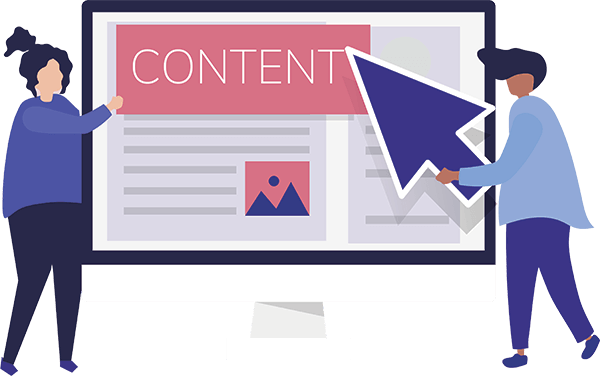Content Development
Our Exact Step by Step Process

Content development is one of the most important yet underrated activities you can do for your website presence online.
Yet so few people know how to consistently create great content to serve their website or business objectives.
In this guide, I’m going to dive deep into our exact content development process we use at our digital marketing agency.
I’ll be covering the following topics below.
Skip to any chapter your heart desires.
How to identify your perfect audience to quickly attain your content creation goals.
Choosing the right topic to maximize your content development efforts.
Focused research tactics to find valuable information your audience craves.
How to best outline your content to get your creative juices flowing.
5 content development hacks to take your writing to the next level.
The most overlooked editing tactics that will make or break your “masterpiece”.
How to supercharge your efforts with visual upgrades & how to systemize it.
Promoting your content like an SEO professional quickly and easily.
Strategic content development tactics to maximize your efforts.
Bonus Section: SEO content development insights.
Conclusion
Before we get ahead of ourselves, let’s start with the basics.
Great content will make every aspect in your online journey easier and more effective.
- You’ll create a loyal readership.
- You’ll brand yourself as an expert in your field.
- You’ll attract potential buyers of your products and services.
From an SEO standpoint, great content is even more valuable.
- You’ll attract backlinks quickly and easily.
- Google will give you preference in your industry.
- People will stay on your site longer and click through to more pages, helping UX metrics.
- You’ll continue growing your exposure with different search terms as you produce more content.
The list goes on and on.
Ask yourself, what’s the one thing you can do that will make everything else easier or unnecessary?
If you want to improve any of the above aspects listed, focusing on content is a great place to start.
Developing phenomenal content WILL make everything else easier.
Just like they said nearly a decade ago, content is king!
So why is it that there’s not much useful information on the web for a content development process?
It’s hard creating content people will love, but “the greats” aren’t just throwing spaghetti on the wall hoping it will stick.
They follow a system that enables them to consistently create great content that their audience loves, year after year.
It’s time to lift the curtain and reveal everything we use to create compelling and effective content with our systematic, step by step website content development process.
Who is your perfect audience?
Simply going after a broad audience isn’t going to cut it.
There are many questions you need to ask yourself…
You have to understand…
- What are their intentions?
- What are their desires?
- What are they interested in?
- What problems are they trying to solve?
- What questions do they need answered?
Asking these types of questions will give you a good idea of who they are.
You can then take it a step further and delve into a tool called Facebook audience insights.
With this tool you can access demographics (like age, gender, job role, location, etc.), information on what pages they like, purchase history, interests, etc.
You can take your desired target audience and find similarities and common characteristics within the data amongst Facebook users.
Simply type in a keyword and start discovering who your audience is based on raw data.
Before you get ahead of yourself and start researching who your perfect audience is, you first need to answer one question.
Understand your content goals.
To better understand who your ideal audience is, you first need to understand your goal of content development.
- Are you building out linkable assets to attract links or perform a link outreach campaign?
- Are you promoting your product that solves a common problem in your industry?
- Are you branding yourself as an expert in your field?
- Are you developing content to generate more leads for your newsletter?
Focusing in on your biggest reason why for developing content will enable you to pin point exactly the type of person you need to write content for.
Sometimes your purpose for writing content won’t align with obvious goals.
IE: I run a digital marketing agency, so attracting clients with my content would appear to be my main focus. However, a lot of my content is aimed for other digital marketing professionals so that I can attract backlinks, raise my domain rating, and make it easier to rank for “money” keywords down the road.
Fortunately, with web content you can accomplish multiple goals.
However, it’s important you don’t go all in and try to do everything as this might muddy the waters and minimize the effectiveness of your content.
For instance, let’s say your goal is to create a linkable asset used to attract links to your site.
If you develop that content with the intent of making a sale as well, you will hurt your chances of attracting as many links.
By laser focusing in on the goal you have for your content, you can begin asking the RIGHT kind of questions to discover who your perfect audience is.
Once that’s done, cater your content to them with the end goal in mind.
What’s the best way to do this?
Think about your audience and end their search.
Providing content that helps your audience achieve their goals is the most surefire method to accomplish your own content development goals.
Imagine your audience is searching Google for an answer to one of their biggest problems.
You need to provide precisely what they’re looking for.
Put yourself in their shoes, at the very moment they’re searching on Google.
Ask yourself precisely what would solve their problem, answer their question, or scratch the itch they’ve got.
Then simply plan how you can provide this for your audience within your content.
Pro Tip: Expect nothing in return, just give it to them upfront and become as helpful and clear as possible.
As an SEO, I can’t help but recommend you focus on providing content that will end their search.
The reason why is not only will you benefit by accomplishing your goals, but Google will end up rewarding you more.
Google wants to rank the most helpful content that solves the searchers intent for any given query typed into Google.
Google doesn’t just track behavior metrics to provide a neat little tool called Google Analytics.
They’re tracking this information to also provide their algorithm with a clear picture of which content is best suited for any given keyword.
By answering the most prevalent questions, solving the most important problems, or providing whatever it is your audience is searching for; the behavior they exhibit on your site will be tracked.
- They won’t click the back button.
- They’ll stay on your site longer.
- They’ll interact with videos, forms, inner-page links, etc.
- They’ll revisit your site.
If these tracked behaviors outperform your competitors, this indicates to Google that your page is best suited to be shown at the very top.
This means you must provide the exact experience your visitors are looking for, and you must do it better than anyone else.
We’ll cover some smart tactics how to do just that in a later phase within this guide.
Before we get ahead ourselves, you must choose a topic that’s worth your time. This next phase goes hand in hand with identifying your audience and content goals.
Once you develop a clear picture of who your audience is, what your own goals with content are, and how to best end your audiences search; choosing a topic will become easy.
Using what you’ve already discovered in the first phase, you’ll have a road map that will point you in the right direction.
There are strategies to help you really get the most out of your topic choice.
You must be strategic, otherwise you’ll end up wasting time, energy, and resources.

Find a topic that is big & broad.
I want to address the importance of WHY choosing a broad topic is important.
This may seem counterintuitive based on your previously acquired SEO knowledge but stay with me and I’ll explain.
Yes, I understand there are obstacles in choosing broad topics…
- There’s more direct SEO competition with sites having powerful backlink profiles.
- There are more people competing for the terms.
- The internet is saturated with content around broad topics.
- It’s hard to “reinvent” the wheel.
However, Google wants to rank a page it considers the authority on any given topic.
The more in-depth you are with a topic, the more likely Google will consider you as the authority.
Using broad topics, you can really break down the sub topics and expand on them within your content.
This will enable you to hit on all points and give you an opportunity to provide the solutions and answers from all angles.
By providing such in-depth content for your chosen topic, your audience will stay on the page longer, click through to more pages, and interact more with your site.
Why? It’s hard to predict precisely what each visitor is interested in on a person by person basis, but it is easy to cater to their needs when you’re covering all angles.
There’s another reason why I like focusing on broad topics.
A huge driving factor on what topic I choose depends on how many backlink opportunities I believe I can benefit from.
I would much rather write one giant piece of content that overdelivers, covers every aspect of the topic, and outperforms competitor content once every 3 months VS writing a subpar article once every few days.
By producing content about a broad topic and making it the “biggest” and “baddest” piece of content out there, you’re setting yourself up for success with link building.
- The topics are more popular.
- There are more subtopics and angles you can address in one piece of content.
- You’ll be able to speak to a wide array of people.
- You know there’s already a demand for content on these topics.
- Your competitors have existing backlink profiles on this content you can benefit from.
Using simple keyword research tactics and Google “related searches”, you can uncover some incredible topics and subtopics to include in your content.
Let’s dive into the exact strategy I use.
Let Google tell you what they’re looking for.
Here’s a tip. When in doubt, always let Google tell you what they’re looking to rank.
By focusing in on the “related terms” found at the bottom of every search engine results page, you can identify exactly the related topics Google wants covered in a piece of content.

Remember, Google wants to rank content that acts as the authority for any given topic. The best way to do that is by covering every conceivable angle on any given topic.
What better way than developing content that includes what Google “thinks” is related to your chosen broad topic.
You can take it a step further however and focus in on the most important of those terms.
Combine your audience preference with Google related terms.
It’s really easy to give Google what they’re looking for and provide what your audience is looking for at the same time.
Go by search volume.
Using the keywords everywhere browser plugin, you can research the related keywords Google recommends and also get the search volume in real time.
Simply type in your broad topic and document the “related” terms that also get a sizable search volume.
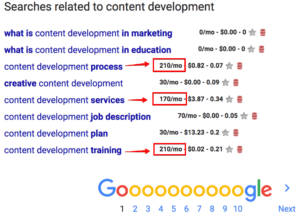 Broaden your search even more by clicking on the related terms and repeating the process on the new results page.
Broaden your search even more by clicking on the related terms and repeating the process on the new results page.
Discover angles proven to resonate with your audience.
Success leaves clues.
By identifying the most popular content on your chosen topic, you can get a better idea on what your audience is really interested in.
Researching this is really easy.
With buzzsumo.com, you can type in a keyword and be shown the most popular content related to that term based on social shares.
Browse through the top shared content and steal some hidden gems. Really dig deep and start jotting down the hidden angles, themes, and ideas about your chosen topic.
Another great tool you can use for this is Ahrefs Content Explorer.
It’s my “go to” tool when finding related content that I can sort by the number of links it has.
What I like most about this tool is you can sort your results by “referring domains”, which will show related content in descending order from the highest number of referring domains pointing to that page to the lowest.
PRO TIP: Choosing the “Sorted by referring domains” will often times generate results that aren’t necessarily relevant. By putting your keyword in “quotations”, you’ll ensure the greater likelihood of showing relevant results.
Choose a topic that needs a gap filled.
The great thing about web content development is that you have access to all your competitors content right at your fingertips.
With just a short Google search, you’ll find incredible content you can piggy back off of when creating your own – But sometimes you won’t find content that’s “incredible”.
This is a perfect opportunity to fill in the gap for the lack of content on your chosen topic.
Don’t just go searching for topics that lack substance.
Still consider your audience, your end goal, and the search volume when choosing your topic.
Sometimes there is content you think might be substantially covered already on the web, but with a keen eye; you can always spot how to make it better.
Just ask yourself these types of questions…
- What questions weren’t addressed?
- What problems weren’t addressed?
- Could the solutions be expanded on or explained better?
- Could the solutions be minimized and simplified?
- Could there be more than one solution?
- What audience is not being addressed with this content?
- Is the content outdated?
- How could you make it better by providing your own unique experience and insight?
- Does the content layout look ugly?
The list could go on and on. Just think outside the box, find a good topic, and make it the best content out there on the web.
Choosing the right topic is sometimes half the battle in content development. By strategically choosing a topic, you’ll level the playing field and attain your goals easier.
The next phase is crucial in your website content development efforts and if done correctly, will make your job a thousand times easier.
Wouldn’t it be great if every time you focused on content creation, you were able to resonate with your audience or look like an expert in your field?
Wouldn’t it be awesome if giving them exactly what they wanted came effortlessly to you?
Not just what they wanted, but what they crave deep down!
With good research strategies, there’s not much holding you back.

What your audience craves.
The goal is to create the best piece of content on the subject.
Sometimes that’s easier said than done.
A big reason why is because your point of view is subjective.
Often times, what we think is best for our audience is not quite what they’re looking for.
You can put yourself in your audiences’ shoes, but sometimes it’s not going to cut it.
Luckily, you have all the tools needed in today’s day and age to better understand exactly what they’re looking for.
The trick is to let the market and existing data tell us what’s most interesting to your target audience.
Only then will you be able to directly speak to them.
Take out the guessing work with the following strategy.
How to pinpoint what your target audience likes.
Success leaves clues!
The “pros” don’t offer content development services and then shoot darts blindfolded.
There is an art and science to figuring out exactly what you should include in your content.
Using previous tools already recommended (Buzzsumo and Ahrefs Content Explorer), you can effectively pin point precisely what performs well in your industry.
Pro Tip: Type in authority website URL’s within your niche into Buzzsumo and Ahrefs Content Explorer to find their best performing content. “Psst… With Ahrefs Content Explorer, you can organize your results by numbers of shares, tweets, search traffic, etc.”
In the previous phase, I recommended you jot down angles, themes, and ideas.
In this phase, you’re going to want to dive deeper in your research.
Don’t just search for content on your broad keyword.
You’ve already documented sub topics related to your niche in the previous phase.
Take the list you made of your main topic and all the sub topics, then start researching.
Start jotting down ideas and pieces of information that the best performing content has covered for each specific sub topic.
Once you’ve done this with Buzzsumo and Ahrefs, head over to Google and repeat this process reviewing the ranking pages. Do this for the first few pages in Google.
Whether you want to believe it or not, Google has gotten pretty damn good at their job.
Chances are, the information you research on the topic will reveal a substantial amount of information you’ll need in the development of your content.
Note similarities between each piece of content.
The last step in the research phase is crucial.
Often times you’ll find niches that use a prevalent form of content.
As you’re going through your tools and Google, make note of what type of content is ranking the highest and has the most links / social shares.
- Are they predominately using listicles?
- How to guides?
- Is humor used?
- Is it fact driven backed by statistics?
- Are references cited to help the writer make a case?
Chances are if you find a pattern of writing within an industry, it’s that way for a reason.
While it’s important to be yourself when developing content; if I was a betting man, I’d feel safer following the trends and “voice” of an industries audience.
Now that you’ve done your research, it’s time to organize it in a way that makes sense.
Finding the right topic can be stressful, researching can be tedious, and actually writing your content may seem like a monumental task.
Outlining your content though is a breeze.
Partly because you’ve already done most of the work.
Now it’s time to fit the pieces together.
Creating a bird’s eye view of your masterpiece.
Get your blank slate and write “intro” and “conclusion”.
Then in between those two words, begin outlining your points.
Don’t worry about the order, just write.
Go through your existing notes and make bullet points of the major and minor points.
Start with the major points that need to be covered. Then list the minor points below each appropriate section.
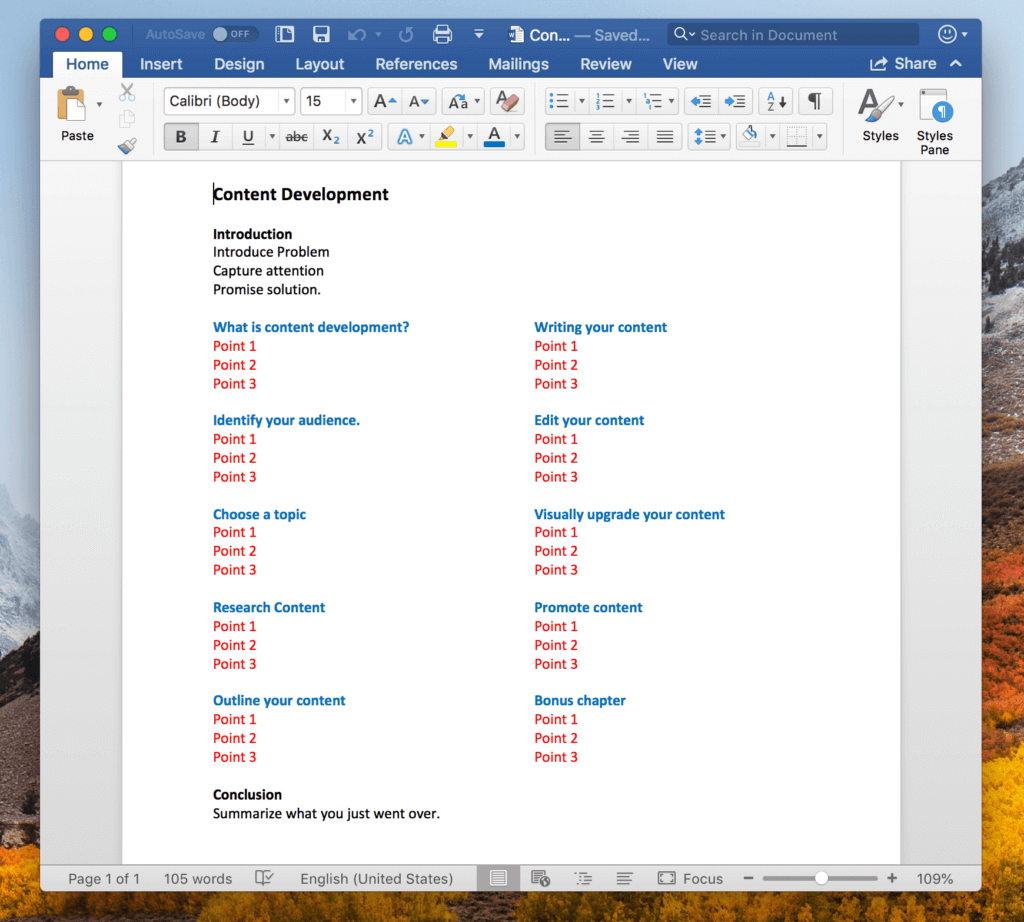
PRO TIP: I know this is an obvious and “elementary “approach. I can’t tell you how many times I’ve come across a piece of content that did phenomenally well that merely pieced together a bunch of obvious and simple strategies. Sometimes it’s just piecing together obvious tactics the correct way that gives the “aha” moment to your reader.
Ask yourself what’s missing.
Once you’ve created a nice birds eye view of your “masterpiece”, you can really start expanding on ideas to make it your own.
- You can spot problems that haven’t been widely discussed.
- You can spot gaps in topics not yet explored.
- You can expand on topics that haven’t been adequately covered.
- You can address the unanswered questions no one took the time to write about.
- You can spot how to make it more informative for your readers.
With everything right in front of you, you’ll be able to spot how you can make it the best piece of content on the web.
Having every important aspect of your topic in front of you will help spark your imagination and help you think outside of the box.
This is a phenomenal idea generating strategy.
You’ve heard of this before. It’s called “brainstorming”.
All jokes aside, as obvious as it seems, you’d be surprised how few people do this.
The idea for your outline is to take the top content on the web and piece together all the talking points.
Then think up ways to make your content more comprehensive or helpful.
If you’ve outline THAT piece of content, then you’re on the right track.
Once you’ve created your outline, it’s time to get organized.
Piece together the puzzle in the correct order.
Chances are you already have a good idea of how the content will flow.
Whatever your topic is, whatever argument you’re making or problem you’re solving, there is a logical progression of ideas.
Only you can know precisely how it fits together, but it’s important that you give it a little thought.
This is a fluid process. It’s almost like a dance.
This is where your creative content development skills will really help out.
You see, it’s not about being “creative” to find topics or content to write about.
All of that is already at your fingertips with just a short Google search away.
It’s about making all of your points fit together within a nice “tapestry” so to speak.
The ideas’ might not be your own, but the way you fit it all together ends up being yours.
Once you have a complete picture of where your content is headed, then you can add in your own unique ideas, insights, and experience.
Now it’s time to start filling in the blanks and expanding on each topic within your outline.
Remember when I wrote earlier that this seems like the “monumental” task?
If you properly researched your topic and outlined your content appropriately; this is actually quite easy.
Just write.
I had to include this as one of the “hacks” because it’s so darn simple it just works.
So many people say they have trouble with content development when really, they’re just being lazy.
Simply go down point by point from your outline and start writing.
- Don’t think too much.
- Don’t skip a beat.
- Don’t read what you’ve already written.
- Don’t stop
Often times, we all get caught up on making everything perfect.
You want things “just right” but you fail to realize that this is your first draft.
Make your mistakes! Get it all on paper.
That’s why editing exists.
THEN you can go back with fresh eyes and realize your “stupid” mistakes later.
Cure for the simple writer’s block.
Here’s the beauty of outlining your entire piece of content first.
All you need to do is expand on the topics.
If you get stuck on a topic and experience writers block, go over your notes and skim some material on that particular topic.
This will jog your memory, inspire you, and get you thinking in the right direction again.
It’s the simple steps that really make a good content development plan.
People like to overcomplicate things when really all it takes is just a little common sense and you’re back on track.
Ask your target audience.
You could study the most comprehensive content development training on the market and fall flat on your face if you don’t speak directly to your audience.
Sometimes the best way to do that is to just ask them questions.
If you’re a business owner, get to know your customers and ask them about your topic.
If you’re a blogger, engage your audience in conversation within your comment section.
Sometimes people will reach out to you via email expressing interest in your writing. Get to know those people and get their opinion.
Ask on social media groups, go to forums, find people that fit your audience in person.
- Ask them what their biggest problems are with your chosen topic.
- What are their biggest desires.
- What are their biggest questions.
- What are their biggest fears / concerns.
Ask your target audience these questions. Pick their brain.
You’d be amazed at how much useful and insightful information you can receive by just asking.
Once you’ve gotten to know a handful of people in your audience, you can really get in their heads and understand which direction to take when you start writing.
- This can shed light on important issues you didn’t think of before.
- You can use personal stories they’ve shared.
- You can dive deeper into common concerns they all share.
- You can address questions you might not have thought of.
The skies the limit.
The bottom line is, the more you’re able to speak directly to your audience, the better your writing will become on that topic.
The more detailed and comprehensive you can get, the better.
This is another simplistic approach to better writing.
Just be more detailed and focus on content development that is more comprehensive than your competitors.
There’s no magic bullet to writing great content.
It’s just a matter of who’s willing to put the time in, and who’s not willing.
If you did a good job on the research and outlining phase, it’s just a matter of filling in the blanks and paying attention to the details for every point you laid out earlier.
The goal is to provide content that ends your visitor’s search.
By going above and beyond what everyone else has provided, you’re nearly ensuring success.
It just so happens also that Google prefers longer content.
So long as you stay within the topic and provide incredible value; that alone can help you rank higher in the search engines.
- You’ll naturally attract more links.
- More people will want to share your content.
- Google will view your page as an authority on the topic.
Remember, Google wants to rank the best content out there.
By diligently covering every aspect of a topic, you’re telling Google you’re an authority on the topic.
If you do a good job and engage your visitors, that will produce a lower bounce rate and longer time on site, further cementing your “authority” status with Google on the topic.
Not to mention, the best piece of content on any given topic will naturally attract more backlinks.
Promoting that caliber of writing and doing effective link outreach strategies makes it a downhill battle.
The problem is, sometimes you can’t write if your life depended on it. Maybe you just don’t have the time.
Luckily, there’s a way around that as well. So sorry, but you really have no excuse.
How to manage and hire a good writer.
Another approach is to hire a writer who’s in the industry on whatever your topic is about.
You can find local bloggers on the topic and approach them.
Here are a few rules you should follow when hiring writers.
- The writer must have knowledge of your topic.
- Avoid content writing services. (They usually produce poor quality content.)
- Ask for examples of their best work. (Did they get a lot of social shares / comments?)
It doesn’t have to be expensive. Hiring a writer full time is not necessary.
You can find people that will do it per project.
You can find writers from a few different strategies.
Upwork
You can post a job on upwork.com and wait for writers to apply. Simply review some of their work, gauge your budget with their asking price, and hire your first writer.
Upwork is a great place to find writers on the cheaper side.
Sometimes the quality of their work reflects their cheap price.
Other times you find that hidden gem that does great work at a low cost.
Problogger
This is another great option to find competent and knowledgeable writers for your website.
Visit their job board and simply post a job.
If I had to choose, I would encourage you to stick with Problogger.
They can help you find some incredible writers that know everything they need to know about whatever topic you’re working on.
Social Media Freelance Writer Groups
Another route is to join Facebook groups like this one.
It’s really simple. Join the group, post a job, watch the private messages roll in with qualified writers that know a lot about your topic.
Industry Leading Websites
The last strategy to hiring writers involves reaching out to people who write for industry leading websites.
Step 1: Just type in your niche keyword + “blog” into Google.
Step 2: Find contributors/authors who are writing for these sites.
Step 3: Try and find their author bios page, or search for their social media pages.
Step 4: Contact them via email (if you can find it), or social media and ask if they do freelance writing. Stress how you’d love to hire them.
It’s a very simple process that anyone can do. Don’t overcomplicate it.
How to coordinate and manage your writers.
The last piece of the puzzle is ensuring they do good work for you.
If you find a good writer, you don’t need to micro manage them. In fact, micromanaging them might not go over too well if they’re talented.
You can have a writer churn out some amazing content in 3 simple steps.
Step 1: Simply give them the URLs of the popular content you already documented.
Step 2: Show them your outline you created.
Step 3: Tell them to put the content in their own words and expand with their unique insight and experience.
If you decide to hire a writer, you might be tempted to overcomplicate things.
That’s what people tend to do when they’re stepping out of their comfort zone.
Resist the temptation.
Seriously, content development doesn’t have to be hard.
If you hired a good writer, did adequate research, and drafted a useful outline; the writer will do a wonderful job.
After you get your content written, it’s time to edit your masterpiece.
You don’t have to dread this phase if you look at it the right way.
I look at it as an opportunity to watch my hard work transform into the masterpiece it’s meant to be.
Taking a seemingly jumbled set of ideas I’m disappointed with, and turning it into something I’m proud of.
Here are a few strategies I use every time I edit my content to get the job done effectively and quickly.
Fresh Eyes
Take a break for a day and read it over with fresh eyes.
I can’t tell you how many times I’ve written my “masterpiece”, only to make dozens of changes just 24 hours later.
I don’t know the reason behind why this is the case, but I’m not complaining.
The simpler you can make your life, the better.
It’s a very easy strategy that can make a huge difference.
If you’re doing some web content development, don’t click the publish button just yet.
Sleep on it first.
Additional information
Sometimes you won’t know if anything is missing until you’re done with your first draft.
Only then can you truly see the big picture.
Adding additional information doesn’t have to mean doubling the size of your content.
It could be just a few extra details to really “deepen” your content.
Believe me, these little details go a long way to providing the extra value over your competitors.
- You could add statistics.
- You could add personal mini case studies.
- You could add related insights.
- You could cite references to points that you’re making.
- You could embed short videos covering your topic.
- You could recommend related websites on your topic.
- You could link to related online tools or resources to help your visitor.
You’re only limited by your imagination.
Objective party
Sometimes taking a break from reading your draft won’t help.
You’re too mesmerized (or arrogant) by your brilliant writing skills.
Ask a coworker, friend, or relative to read over your draft and ask for their honest opinion.
If they truly care about you, they’ll be honest with you.
If you’re writing a lot and can manage, find someone to join your “buddy” system.
If they write something, take a look at it for them and give them your honest feedback, and vice versa with your content.
Making the Cut
The world might not be ready for that one revolutionary idea you included in your content, or maybe you’re just too “wordy” like me.
Either way, be ruthless with yourself and try to cut points that might not necessarily belong in your content.
This is a great content development methodology every great writer should adhere to.
Make sentences shorter, avoid adverbs, and drop your tangents.
Editing is an important step in your web content development process.
It’s time to take it to the next level and supercharge your efforts.
You get this next part right, and it truly will make everything else (lead generation, branding, link building) much easier!
In this day and age, putting a “pretty bow” on your page should be a fundamental part of your website content development strategy.
Looking “good” has always been a reality that we have to deal with on a day to day basis.
If someone is dressed well, they’ll be trusted more, gain more business, and look more successful.
The same goes for your website content, or anything else for that matter.
Our subconscious desire to judge based on the appearance of people, places, and things is often times overpowering and happens without us even realizing it.
The goal is to make your content look like “a million bucks”, but without breaking the bank.
Let’s face it, a huge part of the impression a website makes on us is how it looks.
I very rarely stay long on a cheap looking website.
Even though I logically know the aesthetics of a website in no way affect the quality of information on the site, my subconscious screams at me “amateur”.
You’re kidding yourself if you think it doesn’t matter.
Fortunately, there are many ways to address this quickly, easily, and affordably.
Graphic Designer | Web Developer
The first option I’m recommending is obvious, but some people might not be able to afford an inhouse full time web developer.
A great alternative is to find someone overseas where the dollar goes much further in their economy.
Don’t be naïve, you can find someone incredibly gifted, smart, and knowledgeable just about anywhere in the world.
You can go find outsourcers that are overseas on a multitude of sites.
My recommendation would be to hire someone yourself and avoid relying on outsourcing companies as they will upcharge you on the cost.
A great website I found is Online Jobs, where you have a lot of control over the hiring process, the background checks, and so much more.
A close second would be Upwork, but you should really do your homework and check past work the prospects have worked on. (This is a good practice no matter who you’re hiring.)
My recommendation for hiring someone would be to make sure they have a lot of experience with CSS and HTML at the bare minimum.
Plugins
You don’t have to know a snippet of code to make your media presentable.
Using plugins, you can visually upgrade your content yourself easily.
Here’s a list of some of the plugins I’ve used over the years.
Rev Slider | WP Bakery | Elementor
These types of plugins are designed to help anyone regardless of their web development skills to visually upgrade your website.
Each one has pros and cons, so take a peek through them all to see which one will work best for you.
If you’re on a budget and have a little extra time on your hands, this is a great route to go.
Sometimes you won’t need to make it super fancy in order to get the job done.
This next tip can help take you 80% of the way to visually upgrading your website content development, without any of the web development skills.
Easy visual upgrades
Option 1: Pictures
As you guessed it, pictures can go a long way to making your content more professional.
The higher quality pictures you can use the better, but sometimes the paid subscriptions can get pricey if you’re on a budget.
Sometimes it’s worth it though, so if you go that route, I would recommend you visit Shutterstock.
Using a lot of pictures is great to improve the look of your content, but it can slow down your page speed quite a bit.
This in turn can negatively affect your SEO.
A quick fix is to minimize the size of your JPEG, and PNG files.
Another great alternative is to utilize your screen capturing abilities. If you have a Mac, it’s already built in. If you have a PC, download Jing.
Screen shots are especially useful if you’re writing instructional pieces of content.
When you accompany steps someone can take online with a picture demonstrating the steps, you can really ramp up the usefulness of your content to your site visitors.
There are a ton of apps that can help you edit your photos by adding red arrows, boxes, etc.
Option 2: GIF
Believe it or not, GIF’s aren’t used as much as I think they should be used.
These can be instrumental in separating the quality of your content development with other competitors, especially when you’re showing how to do something online.
Maybe you have an online service – Using GIFs in your FAQ that show how to navigate the site is huge.
Maybe you’re selling a software – GIF’s can provide step by step instructions on how to use the software.
There are many uses a GIF can bring to the table, you just have to think outside the box.
I personally use Giphy Capture, which can help me make GIFs in under 60 seconds.
- It’s easy to use.
- It’s quick to use.
- It’s free.
Aaaaaand…. It’s only for MAC. Do your research and find a good one for PC.
Point is, in today’s day and age, you don’t need to have a degree in computer science to do web content development.
Everything you would need is at your fingertips.
How to systemize your visual upgrades
This is an important solution to focus on if you want to start developing visually beautiful content on a massive scale.
If you have a web developer, it’s really quite simple to accomplish.
If you don’t however, the same concept they would use applies to your content development process as a whole.
The trick is to identify issues (from a visual point of view) and document simple tasks that will remedy these issues quickly and easily.
Document the common problems and accompanying solutions for your own convenience.
Page too slow? Plug the URL into Google Pagespeed insights and follow the instructions.
Are blocks of text straining your viewers eyes? Turn that block of text into a slider with the Rev Slider plugin I recommended earlier.
Having trouble explaining your step by step process with words? Show your viewers instead with GIF’s.
Document each problem, document the solution, then make a quick video with Jing.
Soon it will become a library of solutions that you can delegate out to someone else on the team.
Pro Tip: Go overseas with these documented problems and solutions then hire people in a country where the dollar goes much farther. Most of the solutions I just listed do not involve special knowledge. You can turn your really long and ugly content into a beautiful piece of work for under $10.
For a skilled web developer, having a website content development process can save a huge amount of time.
Not only that, because of their high skill level you can accomplish a lot more sophisticated “visual upgrades”.
The same concept applies, but the solutions you document won’t be as simple.
I’m a self-admitted web development novice.
I wouldn’t even begin to understand how to streamline this, nor would I pretend to know how to give instructions on it.
You can direct them though, which is precisely what I did for my projects.
I approached my web developer and asked her to begin making a “library of problems and solutions.”
It’s really quite simple.
Step 1: Define your “problem”.
IE There is a big block of text in the content.
Step 2: List the solutions that can be used to fix the problem.
IE Create a text box graphic / Add a photo / Break it up into a separate section with a slightly different background color / Create a dropdown affect
Step 3: Have your web developer document the code necessary to implement each of the desired solutions.
Step 4: Make it so that anyone on the team can access this “cheat sheet” at any point in time to get the job done quickly and easily.
The best way to do this would be to use Google Docs.
It’s a great way to collaborate with your team members efficiently.
Anyone on the team can access it, you can share information, you can edit it or make recommendations in real time.
It’s really a great tool to use.
Step 5: Rinse and repeat for all problems you’ll come across when visually upgrading your content.
This will help you save time and enable your web developer to move quickly to cover more ground.
This will also enable you to let any new web developer pick up your website content development process immediately upon hiring them.
So, you’ve created your masterpiece. Now it’s time to showcase it to the world.
I’m putting this chapter together because a big misconception is that all you have to do is create content, and the rest will fall into place.
- People will find your content.
- People will automatically link out to your content.
- People will share it and it will go viral on its own.
WRONG!
This is so far from the truth it hurts.
As someone who does this for a living, I can tell you that you don’t want to leave this up to chance.
It is absolutely a crucial piece of the puzzle.
Get this wrong and you might as well quit creating content. Nothing is handed to you, especially online.
So long as you created amazing content, your promotion phase will be relatively smooth.
Here are some quick how to guides explaining just a few promotional strategies you can use.
SEO Link Building
There’s obviously not enough time to go over every link building strategy in just one article.
While there are some pretty advanced link building tactics out there, often times it’s the simple tactics that yield great results.
What I want to cover is a well-known strategy that anyone can do.
It’s called the skyscraper tactic, and it’s very easy to implement.
Imagine a skyscraper in the city. It’s famous because it’s the biggest and tallest one out there.
You come along and build your own skyscraper and stack on 50 floors. Now you have the biggest, most famous skyscraper out there.
If you’ve already followed my website content development suggestions, you should already have written the most informative, incredible content on whatever topic you chose.
It’s answered all the burning questions on the topic, solved the biggest problems, and covered all the angles that haven’t to this point been addressed in one place.
You should now have the best piece of content available on the web.
What now?
Tell the world about it.
Step 1: Researching with Buzzsumo, make a list of all the web pages out there that have the most social shares on the topic you’ve written about.
Step 2: Using a feature in Buzzsumo, download the list of twitter handles of those who shared the content, then reach out to each twitter handle with your piece of content. Explain how it’s the most comprehensive content available on the topic.


Step 3: Then using Ahrefs Content Explorer, make a list of all the web pages that have the most backlinks pointing to them on the topic you’ve written about.
Step 4: Plug in each of those sites you found from Content Explorer into Ahrefs Site Explorer, download the list of sites that linked out, find their contact info, and reach out to them the same way you did with those who shared it in the above step.

Step 5: Document all the pages ranking on Google for all related terms associated with your topic. Plug each of them into Ahrefs site explorer and repeat the rest of step 4.
Use Findthat.email to find the best contact info for each of your link outreach prospects.
Upload your list of contacts to SalesHandy, personalize your outreach message, and blast out your email to 1,000 + people automatically.
Here’s why I love the skyscraper strategy so much.
You’re only approaching people who have already proven to share or link out to existing content that’s similar.
They’re clearly interested, and not only that, they actively link out to or share content like yours.
By approaching them with clearly superior content, you’re ensuring a large amount of people will share it and link out to it.
Pro Tip: Spamming these people with your content unsolicited might not be welcomed. In your first email, ask them permission to send your article. When they say yes, send them your second email with the link to your content and ask for the link.
Notice I really went through this strategy quickly.
The reason why is because I really want to drive the point home to you.
If you want to want to make everything else easier, make great content.
You get that right, even simplistic link building methods you mess up on will work wonders
Repurpose your content | Social
Just because you worked so hard on your masterpiece, doesn’t mean you’re finished.
Here are a few extra steps to really stretch out your efforts.
Step 1: Post it on Twitter, Facebook, and LinkedIn.
Twitter and Facebook are pretty self-explanatory.
It’s LinkedIn I want to dive a little deeper into.
You can “publish” content on LinkedIn.
Obviously, you don’t want to just copy and paste your entire content onto LinkedIn.
What you can do though, is write a tiny blurb introducing the topic, or just post the first paragraph.
Then you can hyperlink to your actual content using “Read More…” as the anchor text.
I’ve found that LinkedIn can be an incredibly powerful way to repurpose your content.
Here are some other ways that can really boost your presence.
Repurpose your content | Additional Views
Step 2: Actively participate in other well-known sites.
Quora is a great place to get a lot of eyeballs on your content.
Quora is a site where people can ask anything, and industry professionals can answer.
What I like to do is find questions related to my content, answer these questions, and then link out to my “amazing” content.
Let’s say I wrote an article about “content development”.
Go to google and type (site:Quora.com “Keyword Here”) just like the picture below.
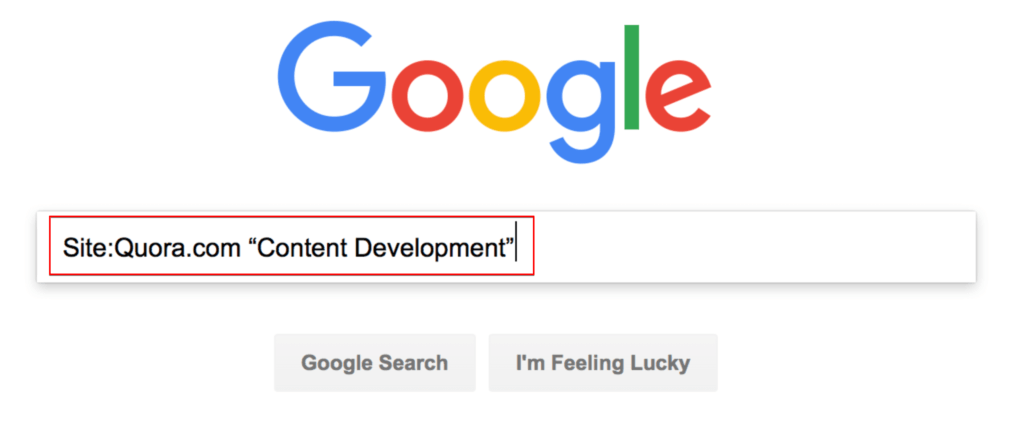
Go find relevant questions pertaining to your topic and answer them “linking to your content for a more detailed explanation”.
Reddit is another great site to promote.
You can’t just spam Reddit message boards though, you have to be strategic.
Do your research first and find a subreddit that will match the desired audience for your content.
The key is you have to find a relevant subreddit, but also one that has some traffic going to it.
You must submit useful content. I cannot stress this enough.
Do not submit content that is subpar or promotional.
If you’ve done a good job with your content development, this should not be an issue.
I stress this because Reddit is famous for having users who police their communities religiously.
Don’t post garbage content, or they’ll tear you apart with down votes.
Keep it up and you’ll get banned.
Don’t let me scare you away though.
It’s a great promotional strategy once you get it right.
Repurpose your content | Every sense of the word
Step 3: Participate in other types of media content development.
Take your existing content you have and create new content with the information you’ve already put together.
If you took my content development training to heart, you should have covered a lot of talking points.
Take a section of your content and make it into a video to publish on YouTube.
Create an infographic, podcast, turn your information into an online course.
You’ve already put the hard work in.
Why not benefit from your hard work and really stretch it out?
This next promotional tip will supercharge your promotional efforts, and you won’t break a sweat doing it.
Influencer Marketing
You’ve worked hard on your masterpiece.
It deserves some attention, but you can’t show it to just anyone.
Why not show it to people who are already writing about it?
Here are a few simple hacks to get in front of an enormous amount of people who write about your topic.
The best part is? Often times they already have a following!
Step 1: Go to Buzzsumo and click on the “influencers” tab on the top.
Step 2: Type in your main keywords. Be sure to put it in “parenthesis” to hyper focus your search.
Step 3: Export to a .CSV file.
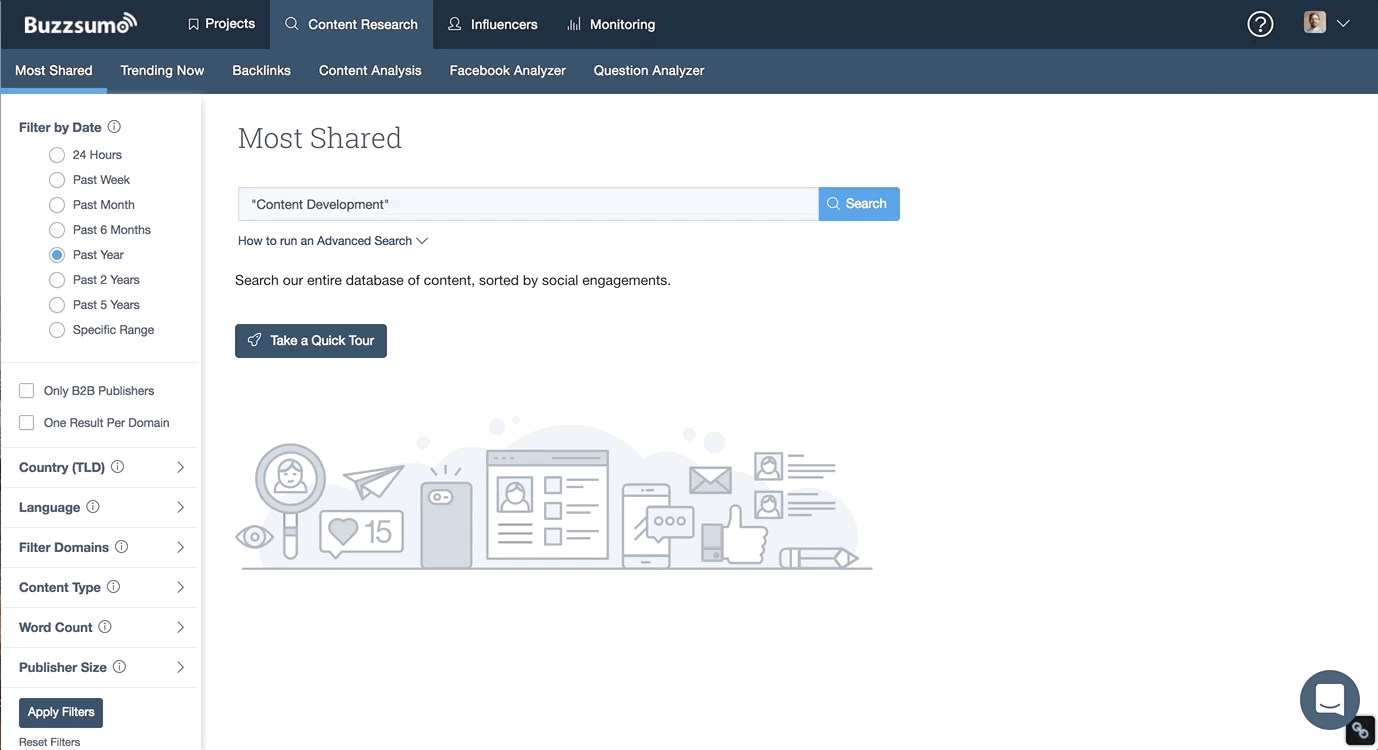
Step 4: Rinse and repeat for all of your keywords you targeted for that topic.
Step 5: Combine your data into one spreadsheet. Remove your duplicates.
Step 6: Use FindThat.Email to find the best contact info, pop them into SalesHandy, and use the same outreach approach as I described for the skyscraper strategy.
Another great influencer tool is Buzzstream.
They have an influencer platform as well that’s great for reaching journalists that specialize in your topic.
I’m not going to sugar coat it, it’s not as streamlined as Buzzsumo.
With that said, the quality of influencers you can reach with Buzzstream far surpass any other influencer platforms I’ve come across.
You won’t be short of finding journalists, contributors, high status guest posters, etc.
Step 1: Type in your keywords.
Step 2: Click the “add to a project” button for every relevant influencer you find.

Step 3: Once you’ve built a nice sized list, go to buzzstreams outreach platform, export the data, find the emails, and commence the outreach phase.

Whether you’re using Buzzsumo or Buzzstream, as long as you’re promoting great content, you will see results.
What’s great about this approach is you’ll find people writing for some big sites and publications out there.
Pssst… A lot of PR agencies use these tactics and then up-charge their clients!
Don’t skip these tactics as it just might make or break your promotion campaign.
Pro Tip: Find a designer on Upwork for under $100 to repurpose your content into a beautiful infographic. Approach these influencers with your infographic. This will separate yourself from the noise and make your inclusion request hard to resist.
Here are 2 strategies that work wonders.
Work with your winners
Maybe you’ve already been participating in content creation for your website and seen some success.
Wouldn’t it be nice if you could take out the guess work for your future projects?
There’s a way to focus your efforts on activities you know will yield great results when creating content.
By spotting content that’s already performing well, you can really ramp up your efforts.
The trick is to know how to spot it.
First you take existing content that’s already performing well.
You can gauge this by looking at a number of metrics.
- Backlink count
- Traffic
- Social shares
- Time on site
- Low bounce rate
- Higher than average comments
Then among the winning pages you’ve noted, ask yourself which of the pages is still lacking.
- Is it full of outdated information?
- Does it look visually ugly?
- Could you include more useful information your visitors could benefit from?
- Did you leave some relevant keywords out?
- What did your competitors include that you didn’t?
Get creative and really try to be honest with yourself.
Once you’ve chosen the winner, get to work!
Take the strategies laid out in this article and make it even better than before.
Then promote it to those who’ve already linked out and shared it.
First thank them for sharing or linking to your content.
Then explain how you’ve updated it with “XYZ information” and see if they’ll be willing to provide additional exposure.
This also opens up doors for exposure through additional shares and backlinks to give it even more of a boost.
If it was popular and well received then, it can only be better a second time around with the updates.
Not only that, but if it has an existing backlink profile, you might be surprised at how easy it is to rank after commencing your second link building campaign.
This idea originally stemmed from an old tactic we use at the agency.
By focusing aggressive link building campaigns on pages ranking on the second and third page of Google, we found that we could do more damage for our clients in the search engines in less time.
Why? Because they already have momentum and a lot going for them.
Bottom line is, it works.
Revamp old content
This strategy isn’t as powerful as the last, but don’t let that discourage you.
There are still plenty of benefits to updating old content, even if there are no previous links or shares built to the page.
Making shorter content longer, better, and more informative will often be rewarded. Google can rank you higher because of these factors.
Also because of the freshnesh update, Google will consider your content “relevant” and “fresh” due to it being updated recently.
Clearly there are benefits to updating old content.
Considering that a lot of the hard work has already been done, it’s a viable tactic to pursue if you want to maximize your efforts and save some time.

Over the years, we’ve made a lot of mistakes.
The process of learning from our mistakes has yielded wisdom that we’ve integrated into our processes.
When we are focused on content development, we always keep this wisdom front and center of our efforts.
Focus on user experience
Now more than ever, putting a focus on user experience with your content development is crucial to ranking higher in the search engines.
As I previously discussed, Google looks at certain metrics to determine exactly how useful the content is for the visitors they send your way.
A good content development process will include strategies focused on increasing these metrics.
Metric 1: Reducing bounce rate
Everyone is in a big hurry. This is no different when we’re searching online.
Your first goal is to let your visitors know that your content will solve their searchers intent.
This needs to be addressed in the very beginning of your content.
Ask yourself why someone would research a topic and want to land on your page. Once you have a good idea, word your introduction accordingly.
By assuring your visitors that their searchers intent will be addressed, you will decrease the amount of people who hit the back button and encourage them to engaging with your content.
Thus, reducing your bounce rate.
Metric 2: Increasing time on site
For obvious reasons, a higher time on site compared to your competitors is a huge indication to Google that your page is addressing the needs of your site visitors.
There are many ways you can increase the likelihood of people staying on your page longer.
- Increase the page speed so people don’t get frustrated and leave.
- Embed engaging videos within your content to keep people longer.
- Make it so that people can scan your page quickly with headlines and sub headers.
Navigation tip to improve your user experience metrics
Something I’ve found that helps both the bounce rate and time on site is how navigation is set up on the page.
For longer content, giving your visitors the option to navigate to the section of content they’re most interested in will peak their interest, get them to interact with your page, and increase the likelihood of reading your content.
The easier it is to navigate your content on the page, the more each visitor will become engaged depending on their own personal searcher intent.
As an example:
- With this content you’re reading, some might read the entire article.
- Some visitors might only be interested in the topic and keyword research sections.
- Others might only be interested in the editing strategies I go over.
Whatever stage of the content development process they’re interested in, they can immediately access it at the top of the page.
What’s great about this is that you can’t predict what topic each visitor is most interested in to keep them on the page.
Everyone is different.
Some topics will be more important than others and it varies for each person.
Having the ability to clearly provide a direct path to each section of your content will dramatically help your bounce rate, time on site, and overall interaction from your site visitors.
The importance of copywriting and content
When most people think about copywriting, they think of sales letters, newsletters, and headlines.
It would surprise some that having copywriting skills will actually help your SEO.
Let’s dive into 2 quick reasons why.
CTR: A higher than average click-through-rate from the search engine results page can help your rankings.
Yes, you should focus on your user experience even before someone lands on your page.
Take a second look at your title tags and see how you could make them better.
The scanners: There are people that don’t ever read entire pieces of content.
Good copywriting goes even farther than just focusing on call to actions and psychological motivators.
Set up your headers and sub headers in a way that your reader will notice.
The goal is you want them to notice and stop to read each section because of how enticing your headers and sub headers are.
Set it up so that a reader would still benefit and understand the flow of the content based only on the headers and sub headers.
If you can let a reader know what your main points are just by them scanning the page, you’ve done your job.
Pro Tip: Provide benefits in your writing if you can. A good rule of thumb is if you can say “so what?” to your benefit, then it’s not a benefit. Try and focus on “the benefit of your benefit”.
Let’s dive into some more SEO content development topics.
Long or short content?
The age-old question!
Do you write one long piece of content occasionally?
Or do you write shorter pieces of content frequently?
I’ve already covered why I like longer pieces of content.
- Google likes long content.
- There’s more of an opportunity to cover the topics and sub topics in depth.
- More value usually means “better” content.
It’s no surprise as well that longer content will generally do better with link building strategies VS short content.
So why would you ever want to do short content?
It’s scalable!
Don’t kid yourself, writing a 1,500 word article is much easier to do on a frequent basis VS 5,000 word articles.
With shorter content, you can pursue a lot more keywords out there.
The more keywords you rank for, the more traffic you’ll bring to your site.
Here’s the problem though…
Most keywords that get a high search volume are very competitive.
Which means you need to increase your overall domain rating (DR) if you want your smaller sized content to rank without as many links built to your contents page URL.
Sure, if you have a DR of 70 or 80, go for it.
It won’t take too many links if any at all to help bump your small content to the top for a lot of keywords.
That’s where frequent content creation makes sense.
But for the vast majority of people out there, they don’t have thousands of referring domains linking to their site.
So, what’s the verdict? What’s the best place to start?
Start with longer content first.
- You can build more links.
- You can build a readership.
- You have a chance to “wow” people more often.
Once you’ve cranked out a few long pieces of content, commence some aggressive link building campaigns.
Stay consistent with it for a while.
Once you’ve built up your domain rating and you’ve built a sizable backlink profile, THEN go in for the kill with the smaller content if you want.
Or just keep developing longer content and continue growing your audience.
This leads me to my last point in my SEO content development rant.
Keep Your Crawl Rate High
Just remember one thing, the goal is to provide content that is great!
The last thing you want is for Google to crawl your site and find a bunch of mediocre content.
This will hurt your crawl rate, as Google bots will start categorizing your site as one that has useless content.
You want every page that Google crawls to be amazing! This will encourage Google to crawl your site longer and more often, which in turn will increase rankings and page views.
We’ve just shared our tried and true wealth of knowledge we use just for clients, and now we’re passing our process onto you.
Treat this as your guide, no matter what phase in the process you’re on.
Most importantly, always remember to take massive action.
The worlds best teacher is failure.
As long as you don’t waste the opportunity to learn from your failures, you’ll continually improve your content development skills.
Please share your thoughts, questions, and your own insights in the comment section below.
